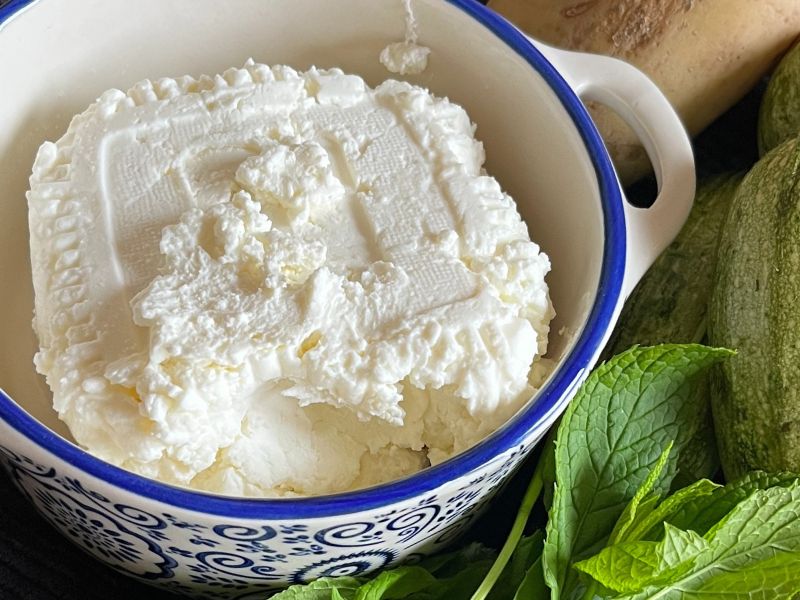
Authentic Chaniotiko Boureki: Cretan Summer Pie
Crete, the largest Greek island, is a mosaic of stunning landscapes and culinary traditions shaped by centuries of history. Among Crete’s many specialties, Chaniotiko Boureki stands out as a quintessential dish of the Chania region. It’s a humble yet deeply flavorful dish that captures the essence of Cretan home cooking—simple, seasonal ingredients elevated by technique and tradition.
Join the My Cretan Recipe Facebook group.
DISCLAIMER: Though you may encounter versions of boureki covered by a layer of crisp, golden phyllo pastry, today, we’re focusing on the authentic version from Chania. In this version, the magic lies in the vegetables, herbs, and cheese melding together in the oven. There’s no need for fancy pastry—just fresh zucchini, starchy potatoes, Cretan herbs, and local cheese.
Chaniotiko Boureki is a dish that tastes like summer and speaks of the land where it was born.
What is Chaniotiko Boureki?

At its core, Chaniotiko Boureki is a baked casserole made primarily of thinly sliced zucchini and potatoes layered with soft cheese, fresh mint, and seasoned simply with salt, pepper, and olive oil, although I love to add some Cretan thyme.
What distinguishes it from other vegetable bakes is its use of local cheeses and a dusting of flour between layers, which thickens the dish as it bakes, creating a subtly creamy texture without the need for béchamel or eggs.

The ingredients are modest, but their combination produces something deeply comforting. Boureki is usually served warm or at room temperature, either as a main vegetarian dish or as a side accompanying grilled meats or seafood. In many Cretan homes, including mine, it’s a staple of summer meals, when zucchini are at their peak. And my kids love it!
The Role of Cheese in Boureki

The cheese traditionally used in boureki is myzithra—a fresh, lightly salted Cretan cheese made from sheep or goat milk. It has a delicate tang and a crumbly, slightly creamy texture that pairs perfectly with the starchy potatoes and soft zucchini.
However, depending on where you live, myzithra can be hard to find. Luckily, there are a few alternatives that come close in both texture and flavor:
- Goat Cheese: You can use a soft cheese made from goat and mix it with some sour cream for extra tang.
- Ricotta: This is perhaps the closest widely available substitute. Use fresh, full-fat ricotta—not the pre-packed kind in tubs—for best results. Again, it is best if mixed with some sour cream to achieve a taste similar to myzithra.
Ricotta Tip
Strain ricotta overnight to obtain a kind of cheese that’s similar to fresh mizithra — perfect for Cretan pies, pastries, or savory fillings. Want to learn more? Check out our full guide: How to Replace Mizithra .

- Feta (crumbled): For a saltier, tangier twist, feta can be used. You may want to mix it with a milder cheese like ricotta to balance the salt.
- Manouri or Anthotyro (if available): These are other Greek cheeses that resemble myzithra in texture and flavor, and they’re excellent in this dish.
Some modern recipes even incorporate a bit of grated graviera or kefalotyri for an extra layer of flavor, though purists may argue that the simple combination of myzithra and vegetables is ideal… and more than enough!
Making Boureki
To make Chaniotiko Boureki, all you need is a handful of humble ingredients—fresh zucchini, potatoes, creamy Cretan cheese, herbs, and a generous pour of olive oil. The key lies in how these simple elements are layered and seasoned to create something far more than the sum of its parts.


You start by slicing the zucchini and potatoes into thin rounds—about half a centimeter thick—and lightly coating them in flour. This helps absorb excess moisture and gives the finished dish a creamy texture without needing eggs or cream.
Then, in a well-oiled baking dish, you begin layering: first the potatoes, then the zucchini, seasoning each layer with thyme, salt, pepper, and generous drizzles of olive oil.


In between the layers, add crumbled myzithra cheese and freshly chopped mint to bring a fresh and tangy lift.
After repeating the layers and finishing with cheese and one last flourish of olive oil, the dish bakes covered at first to soften everything, and then uncovered to achieve that golden, slightly crisp top.


The result is a comforting, richly flavored casserole that tastes like the essence of a Cretan summer—herby, creamy, and full of soul. It’s just as good warm as it is at room temperature and makes a perfect centerpiece for a light lunch or a side dish.

Simplicity and Seasonality
Part of what makes boureki so iconic is seasonal produce. In Crete, zucchini and mint are summer staples. The use of fresh mint may surprise some, but in Cretan cuisine, mint plays an important role in savory and sweet dishes.

Thyme is another herb often used in Cretan cooking, and I choose to incorporate it in my version of boureki (and in my version of moussaka too), because it adds a subtle Mediterranean aroma that rounds out the dish.
Combined with generous amounts of high-quality Cretan olive oil, these ingredients speak to a way of cooking that is as much about flavor as it is about simplicity.
A Dish with Many Faces

While the no-pastry version is considered the most authentic in Chania, some Cretan cooks add a layer of homemade or commercial phyllo dough, transforming it into a pie-like dish. This version is equally delicious, with the added crunch of baked pastry providing a satisfying contrast to the soft filling inside.
But today, we’re sticking to the rustic, casserole-style version that’s more commonly found in Chania’s village kitchens.
Boureki is a forgiving dish, too—you can tweak it based on what you have on hand. Add more zucchini and skip the potatoes if you like a lighter version. Include a handful of sautéed onions or garlic for extra depth. Some even add a touch of tomato, though that’s less common in the Chaniotiko variant.

The Legacy of Boureki
Chaniotiko Boureki is more than just food; it represents the culture of Crete and reflects the island’s reverence for local ingredients, its minimalist approach to flavor, and the enduring wisdom of its culinary traditions.

Authentic Chaniotiko Boureki (Chania-Style, No Phyllo)
Ingredients
- 4 medium potatoes (about 600g), sliced into 0.5 cm rounds
- 4 medium zucchini (about 600g), sliced into 0.5 cm rounds
- 300 grams myzithra cheese or substitute with fresh ricotta or ricotta-feta mix)
- 3-4 tbsp all-purpose flour enough to lightly coat the vegetables
- 1 tbsp dried thyme
- 2 tbsp fresh mint finely chopped just before using
- salt and freshly ground black pepper to taste
- 150 ml olive oil extra virgin (about ⅔ cup) divided for layering and baking
Instructions
- Preheat oven to 180°C (350°F).
- Flour the vegetables:In a large bowl, gently toss the sliced potatoes with 1 to 1½ tablespoons of flour until lightly coated.Repeat with the zucchini slices using the remaining flour. This helps absorb moisture and adds light thickening during baking.
- Prepare the baking dish:Pour a generous layer of olive oil (about 3–4 tablespoons) into the base of your baking tray or ceramic dish, spreading to coat the bottom evenly.
- Layer the ingredients – Round 1:Arrange a layer of the floured potatoes.Season with salt, pepper, dried thyme, and drizzle with about 2 tablespoons of olive oil.Add a layer of floured zucchini on top.Season again with salt, pepper, thyme, and another drizzle of olive oil.Crumble half of the myzithra cheese over the layer.Sprinkle with half of the chopped mint and drizzle with abundant olive oil.
- Layer the ingredients – Round 2:Repeat with another layer of potatoes, seasoning and drizzling with olive oil.Then a final layer of zucchini, seasoned again.Top with the remaining myzithra cheese, sprinkle the rest of the mint, and finish with a generous final drizzle of olive oil.
- Bake:Cover the tray with aluminum foil and bake for 20 minutes.Remove the foil and continue baking uncovered for another 20 minutes, or until golden on top and the vegetables are tender.
- Rest and serve:Allow the boureki to rest for 10–15 minutes before cutting. This helps the layers hold together and intensifies the flavor.
Notes
This authentic, layered version of Chaniotiko Boureki is a staple of Cretan simplicity and flavor, and most importantly, easy to prepare with just a handful of pantry staples.
Serve with crusty bread and a green salad, or enjoy it as part of a larger meze table.
Pin for Later!
Authentic Chaniotiko Boureki



Gabi Ancarola
Gabi is a travel writer who has lived in Crete for over a decade. Through her blog, Crete Insider, she has helped travelers uncover local experiences. Passionate about food and Cretan cuisine, she now attends Greek cooking lessons to bring the island’s flavors straight to your kitchen!
>> Interested in learning to cook in Crete, or discovering all of the top spots to eat in Chania and around the island? Book a food tour or plan your trip with me.













